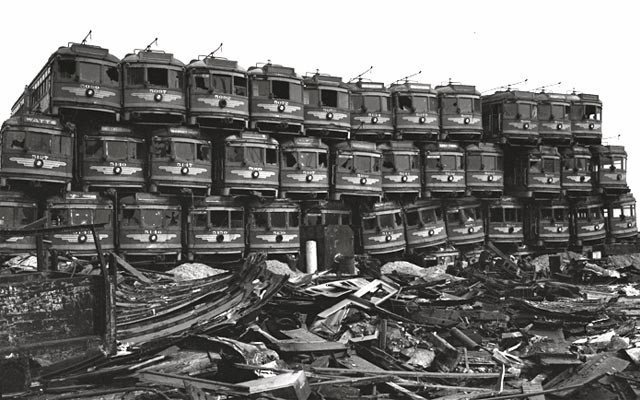Who Killed the Streetcar? The “Snell Report”
Apr 13, 2014. Times Article Viewed: 6961
In 1974, legislative aide and anti-trust attorney Bradford Snell, released a 100-page report on GM and ESSO’s “Secret holding companies”, calling for a restructuring of the American transportation system, starting with the break-up of the Big Three.

When something is done on the largest scale there is a tendency to regard the human element as a force to be tamed and trained, monitored closely and given only a few chances to correct any mistakes or deficiencies. Even worse than the treatment of workers as human robots, is the ordinary low regard for customers or clients who, like the profits being generated, are merely numbers, to be tweaked and teased into an apparently growing figure. Putting our future into the hands of the largest enterprises has proven risks. Diversity and working on the human-scale maybe a little less efficient, but they provide an important link to our past and to one another. On the other hand, there are examples of cases when the interest of the public has been negated, by the agenda of the immense enterprises who are making the key decisions, regarding their activities. There is a government of course, whose job it is, at least partly, to make certain that these private enterprises maintain the public’s interest. When these interests are permitted to dominate the political system, to use their financial leverage to conform public policy to their own requirements, the results can be profoundly destructive.
The “Snell Report” (scanned into PDF format from a rare copy and linked below) was the first widespread disclosure of the role of our largest industrial corporations in the destruction of our vital rail system. It is solid proof that the safeguards which we depend upon to protect us from the dangers of giving too much influence to those with a narrow and self-centered agenda are either ineffective or simply invisible. The ability of the manufacturing and mining sectors, whose products also happen to be crucial in the provision of military equipment, specifically General Motors and Standard Oil, to operate independently of any meaningful restraint by a governmental authority, is very frightening. Since we are no less subject today, to this substitution of the priorities of the many, by the needs of the few, this is no small matter.
Forty years after its original publication, in the aftermath of GM’s bankruptcy, many will find the portrayal of the “Big Three” here to be quaint and out-of-date. It is true that there is a somewhat different reality, with Toyota, Honda, Mercedes, Volkswagen, and all the rest now in the picture. A lot of this new competition, of course, resulted from the failure of the American companies to build better and smaller cars, and this failure to correct their obvious faults, along with their hubris, has eroded, over time, their earlier total dominance. Little has changed when it comes to the status of roadways and their devotion to automobile and truck traffic though. More companies mean more TV ads and manufacturing plants in different States and more political influence.
Some have come forward to dispute a few of the numerous factual claims made in regards to GM’s moves, but the central themes are irrefutable. Mr. Snell has made an invaluable contribution to our ability to use established facts and history, to shine a powerful light upon our transportation system, our government, the media, and the educational system. It is up to us to take the next step, to ratify the global nature of these challenges and the myriad of potential contributors to the creation of the next generation of transport options, to encourage the sharing of ideas about shared vehicles.
We need to make certain that such crucial facts about our recent history be part of our standard curriculum, the story of who we are and how we became ourselves. Can TV tell this story when their commercials are so heavily weighted with car ads? If you are recounting the history of the original inhabitants of this country, and how they have been treated, the broken treaties and all, it would be a mistake to give the job of writing this record, to the liquor or mining industry. If we don’t look hard enough at our past, we will never be able to understand how we got here and what we must do to move ahead.
This document is the Rosetta Stone, the key to understanding the process whereby the Public Interest can be subverted and misdirected by the actions of powerful Private Interests. It is also an indictment of the major media, complicit in the cover-up of these facts, and a demonstration of how quiet, and for how long, that these enormously-damaging assaults upon our common well-being can be kept.
Times Article Viewed: 6961

